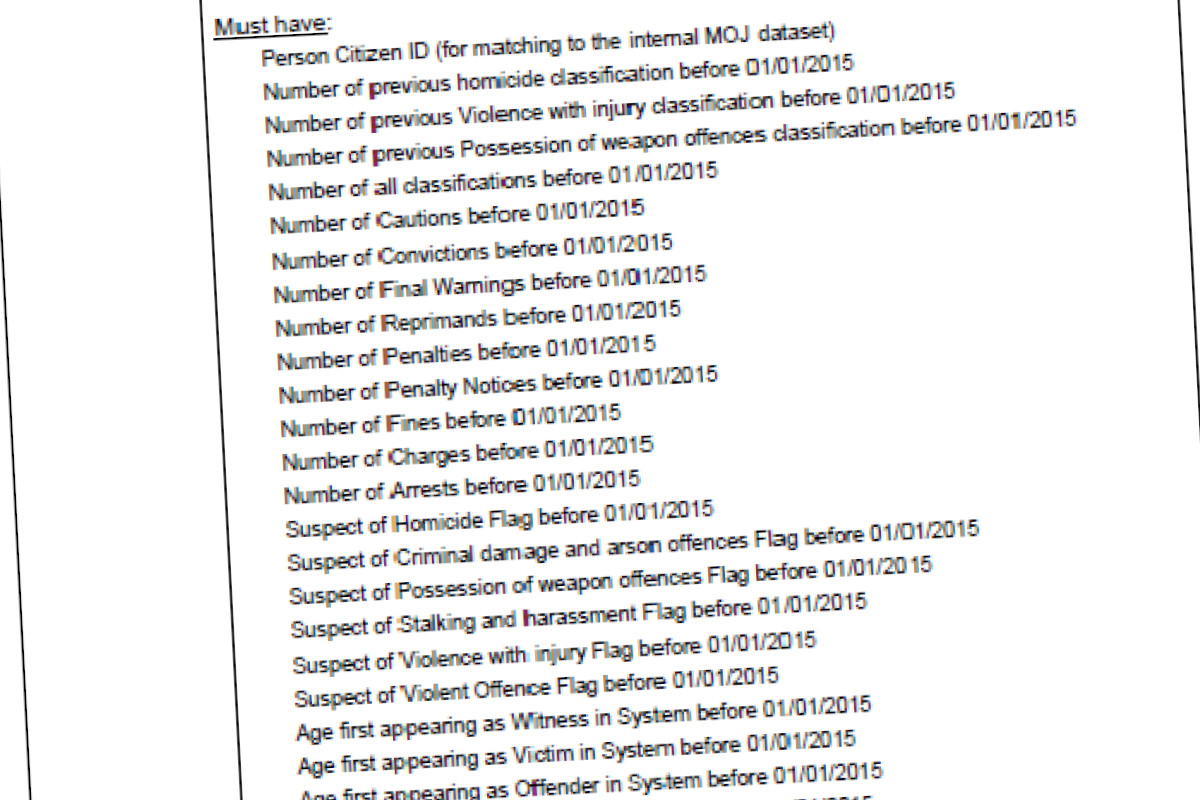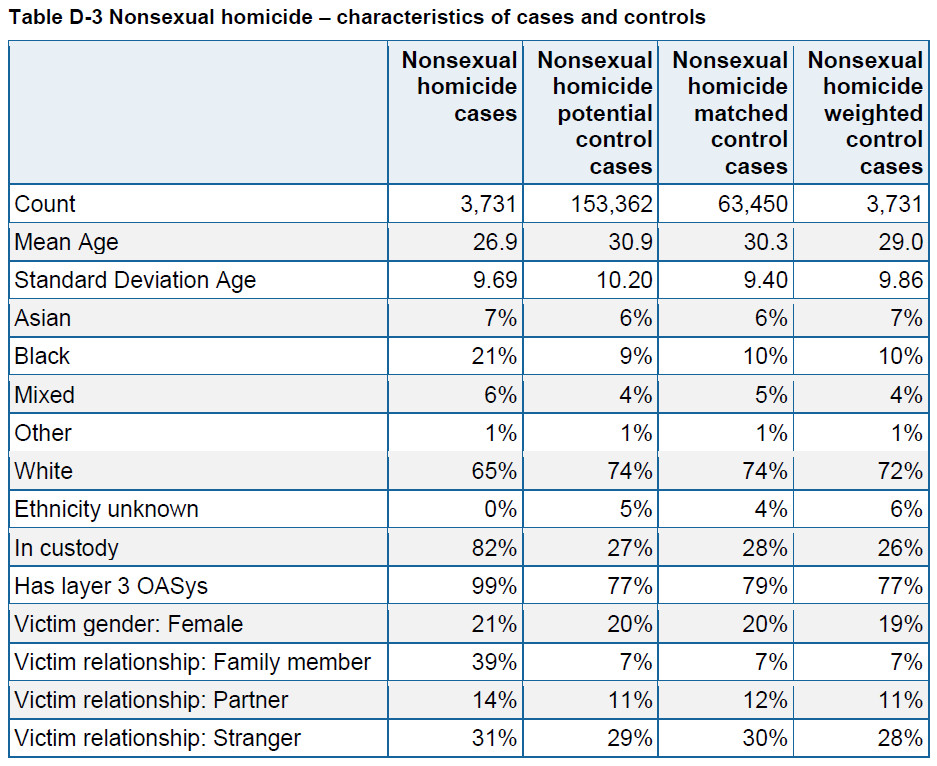UK: Ministry of Justice secretly developing ‘murder prediction’ system
Topic
Country/Region
08 April 2025
The Ministry of Justice is developing a system that aims to ‘predict’ who will commit murder, as part of a “data science” project using sensitive personal data on hundreds of thousands of people.
Support our work: become a Friend of Statewatch from as little as £1/€1 per month.

Text from the data-sharing agreement between the Ministry of Justice and Greater Manchester Police.
This research was covered by The Guardian: UK creating ‘murder prediction’ tool to identify people most likely to kill
The Ministry of Justice is running a secret data project commissioned by the Prime Minister’s office [1] which aims to ‘predict’ who will commit murder.
The Homicide Prediction Project uses police and government data to profile people with the aim of ‘predicting’ who is “at risk” of committing murder in future. It is a collaboration between the Ministry of Justice (MoJ), the Home Office, Greater Manchester Police (GMP) and the Metropolitan Police in London. [2]
Statewatch obtained documents about the project via freedom of information requests. Documents include the MoJ Data Protection Impact Assessment, Internal Risk Assessment and Data Sharing Agreement with GMP. [3]
The so-called predictive tool uses data from the MoJ, the Police National Computer and GMP, to attempt to make these ‘predictions’. [4]
The Data Sharing Agreement between the MoJ and GMP for the Homicide Prediction Project notes that data on between 100,000 and 500,000 people was shared by the force to develop the tool.
Help us expose more 'predictive' policing and prison technologies
Become a Friend of Statewatch
The MoJ says in the documents that the project is intended to “[e]xplore the power of MOJ datasets in relation to assessment of homicide risk.” [5] The MoJ Data Science team then “develops models” seeking “the powerful predictors in the data for homicide risk”. [6] The documents refer to the “future operationalisation” of the system. [7]
The GMP data used by the MoJ to develop the tool includes information on hundreds of thousands of suspects, victims, witnesses, missing people, and people for whom there are safeguarding concerns. [8]
The data also includes information on people in vulnerable situations, with the MoJ stating that “health markers” data was “expected to have significant predictive power”. This includes data on people’s mental health, addiction, self-harm, suicide, vulnerability, and disability. [9]
This project is part of the MoJ’s ‘Data Science Hub’, which seeks to use “data and information to make excellent decisions using cutting edge tools, techniques and collaboration and putting evidence at the heart of the justice system”. [10]
The project was led by the MoJ, GMP, Home Office and Metropolitan Police. [11] The MoJ also held discussions with the Metropolitan Police and West Midlands Police about using data held by the two forces. [12]
The MoJ has developed and implemented other data-based profiling tools in the British criminal legal system to predict offending.
This includes the re-offending prediction tool called the ‘Offender Assessment System’ (OASys). ‘Predictions’ produced by this system are given to judges as part of sentencing decisions, prison categorisation, and also influence probation decisions, such as when someone is released from prison.
Research by the MoJ itself has found that these data-based models rank Black offenders less accurately than white offenders. [13]
Sofia Lyall, a Researcher for Statewatch said:
“The Ministry of Justice’s attempt to build this murder prediction system is the latest chilling and dystopian example of the government’s intent to develop so-called crime ‘prediction’ systems.
“Time and again, research shows that algorithmic systems for ‘predicting’ crime are inherently flawed. Yet the government is pushing ahead with AI systems that will profile people as criminals before they’ve done anything.
“This latest model, which uses data from our institutionally racist police and Home Office, will reinforce and magnify the structural discrimination underpinning the criminal legal system. Like other systems of its kind, it will code in bias towards racialised and low-income communities. Building an automated tool to profile people as violent criminals is deeply wrong, and using such sensitive data on mental health, addiction and disability is highly intrusive and alarming.
“The Ministry of Justice must immediately halt further development of this murder prediction tool. Instead of throwing money towards developing dodgy and racist AI and algorithms, the government must invest in genuinely supportive welfare services. Making welfare cuts while investing in techno-solutionist ‘quick fixes’ will only further undermine people’s safety and wellbeing.”
Support more work like this
Become a Friend of Statewatch
Documents obtained via freedom of information requests
- Freedom of Information Act request response about the Homicide Prediction Project (November 2023, pdf)
- Freedom of Information Act request response about the Homicide Prediction Project (October 2024, pdf)
- Homicide Prediction Project Data Protection Impact Assessment (undated, .xlsx file)
- Ministry of Justice and Greater Manchester Police, Data Sharing Agreement (censored, 18 May 2023, pdf)
- Ministry of Justice, Internal Risk Assessment (undated, pdf)
- Ministry of Justice, Project Timeline (undated, .xlsx file)
- Ministry of Justice, Target variable definition (undated, pdf)
Research conducted by Griff Ferris and Sofia Lyall.
Background information
Previous ‘predictive’ algorithms developed by the Ministry of Justice
‘Predictive’ models used in OASys were found by a Ministry of Justice study to profile people from different ethnicities differently. The study found that the predictive validity (or accuracy) algorithms used by the Ministry of Justice as part of OASys was “greater… for white offenders than offenders of Asian, Black and Mixed ethnicity,” and that they worked “less well for black offenders” and “less well for offenders of mixed ethnicity”. [14]
This shows how these data-driven ‘predictive’ models discriminate against racialised communities, reinforcing the structural discrimination of the criminal justice system.
Previous Ministry of Justice data-based homicide prediction analysis
In 2023, the Ministry of Justice published a new data analysis study on murder predictions based on ‘precursor offences’. Using statistical analysis, the study calculated the supposed likelihood of somebody committing murder based on their criminal history. Alluding to the Homicide Prediction Project, the study’s stated intention was to “contribute to the future development of actuarial predictors of serious reoffending risk”. [15]
The Ministry of Justice analysed homicide rates according to various sociodemographic characteristics, including by ethnicity, stating that: “Nonsexual homicide cases were more likely than their controls – or all potential controls – to be of Black ethnicity, with over 20 per cent being Black”. [16]

Source: Ministry of Justice, 'Escalation in the severity of offending behaviour', 2023, p.79.
The Home Office have previously published data showing homicide rates by ethnicity:
“In the year ending March 1997, 83% of victims and 82% of suspects were White. In the year ending March 2018, the figures were 74% (victims) and 67% (suspects). Rates are disproportionately high for Black victims (4.7 times higher than Whites in the year ending March 2018) and suspects (8.0 times higher).” [17]
The Home Office have also previously published data showing homicide by the affluency of the area, including ethnicity.

It is clear from the data the Ministry of Justice hold and used for this analysis of homicide, the same data which would be used for homicide prediction, Black people are significantly over-represented, as are people of all ethnicities from more deprived areas.
Notes
[1] The project began in January 2023, under Prime Minister Rishi Sunak.
[2] Ministry of Justice, ‘Homicide predictor modelling Full DPIA’, provided by Freedom of Information request response from the Ministry of Justice.
[3] Ministry of Justice ‘Homicide Predictor modelling Full DPIA’, Ministry of Justice ‘Internal Risk Assessment’, Ministry of Justice and Greater Manchester Police ‘Data Sharing Agreement (Redacted)’.
[4] Ministry of Justice, ‘Homicide predictor modelling Full DPIA’, provided by Freedom of Information request response from the Ministry of Justice.
[5] Freedom of Information request response from the Ministry of Justice, November 2023.
[6] Ministry of Justice, ‘Homicide predictor modelling Full DPIA’, provided by Freedom of Information request response from the Ministry of Justice.
[7] Ministry of Justice, ‘Homicide predictor modelling Full DPIA’, provided by Freedom of Information request response from the Ministry of Justice.
[8] Ministry of Justice, Data Sharing Agreement ‘REDACTED – DSA – Homicide predictor modelling MOJ GMP signed’, provided by Freedom of Information request response from the Ministry of Justice.
[9] Ministry of Justice, Data Sharing Agreement ‘REDACTED – DSA – Homicide predictor modelling MOJ GMP signed’, provided by Freedom of Information request response from the Ministry of Justice.
[10] Ministry of Justice, ‘73646 - Head of Risk Assessment Data Science , Data & Analysis, Ministry of Justice (1 role available)’. https://justicejobs.tal.net/vx/mobile-0/appcentre-1/brand-2/candidate/so/pm/1/pl/3/opp/73646-73646-Head-of-Risk-Assessment-Data-Science-Data-Analysis-Ministry-of-Justice-1-role-available/en-GB
[11] Ministry of Justice, ‘Homicide predictor modelling Full DPIA’, provided by Freedom of Information request response from the Ministry of Justice.
[12] Freedom of Information request response from the Ministry of Justice, November 2023.
[13] National Offender Management Service, ‘A compendium of research and analysis on the Offender Assessment System (OASys) 2009–2013' (pdf), 2015
[14] National Offender Management Service, ‘A compendium of research and analysis on the Offender Assessment System (OASys) 2009–2013' (pdf), 2015
[15] 'Escalation in the severity of offending behaviour', Ministry of Justice, Ministry of Justice Analytical Series, 2023. (https://assets.publishing.service.gov.uk/government/uploads/system/uploads/attachment_data/file/1152995/escalation-severity-offending-behaviour.pdf).
[16] “Escalation in the severity of offending behaviour”, Ministry of Justice, Ministry of Justice Analytical Series, 2023. (https://assets.publishing.service.gov.uk/government/uploads/system/uploads/attachment_data/file/1152995/escalation-severity-offending-behaviour.pdf).
[17] “Trends and drivers of homicide: Main findings”, Home Office, March 2020. https://assets.publishing.service.gov.uk/government/uploads/system/uploads/attachment_data/file/870188/trends-and-drivers-of-homicide-main-findings-horr113.pdf
Our work is only possible with your support.
Become a Friend of Statewatch from as little as £1/€1 per month.
Further reading

From Malpensa to Tel Aviv: Italian police use Israeli software to spy on anti-deportation activsts
In March last year, four people were arrested after stopping a deportation flight to Morocco leaving Milan's Malpensa airport. When they got their phones back from the police, they found a strange file – one connected with spying products designed by the Israeli firm Cellebrite.

EU police data plans pose "substantial security and privacy threats"
EU plans to increase police access to personal data could weaken "fundamental rights, legal safeguards and the European economy." The warning comes in an open letter addressed to the EU Justice and Home Affairs Council, and is signed by more than 50 organisations, including Statewatch. The signatories include NGOs, businesses, journalists' unions, lawyers' associations, and others.

UK: Racist violence does not justify proposed expansion of police surveillance technology
Following the racist pogroms that broke out across England at the end of July and beginning of August, the prime minister, Keir Starmer, announced a range of new policing measures - including a proposal for "wider deployment of facial recognition technology." A letter signed by more than two dozen organisations, including Statewatch, says that an expansion of live facial recognition "would make our country an outlier in the democratic world" and calls for the plan to be dropped.
Spotted an error? If you've spotted a problem with this page, just click once to let us know.
